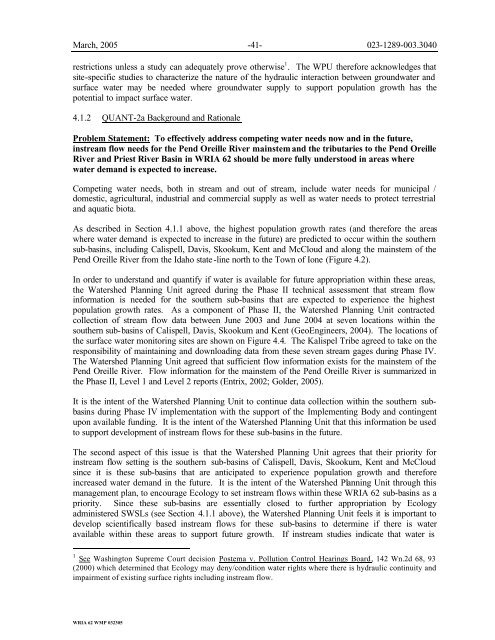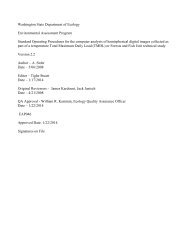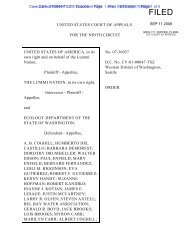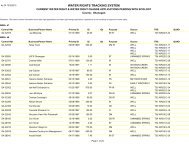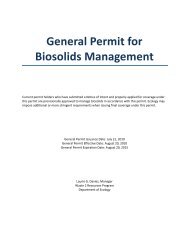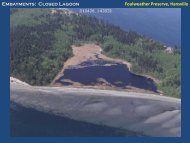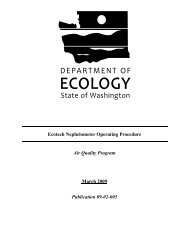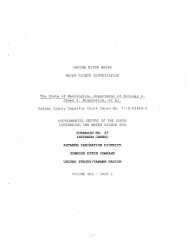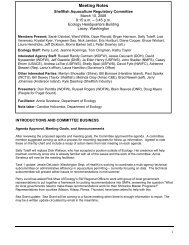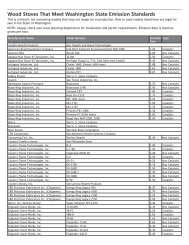WRIA 62 WMP 032305 - Washington State Department of Ecology
WRIA 62 WMP 032305 - Washington State Department of Ecology
WRIA 62 WMP 032305 - Washington State Department of Ecology
Create successful ePaper yourself
Turn your PDF publications into a flip-book with our unique Google optimized e-Paper software.
March, 2005 -41- 023-1289-003.3040<br />
restrictions unless a study can adequately prove otherwise 1 . The WPU therefore acknowledges that<br />
site-specific studies to characterize the nature <strong>of</strong> the hydraulic interaction between groundwater and<br />
surface water may be needed where groundwater supply to support population growth has the<br />
potential to impact surface water.<br />
4.1.2 QUANT-2a Background and Rationale<br />
Problem <strong>State</strong>ment: To effectively address competing water needs now and in the future,<br />
instream flow needs for the Pend Oreille River mainstem and the tributaries to the Pend Oreille<br />
River and Priest River Basin in <strong>WRIA</strong> <strong>62</strong> should be more fully understood in areas where<br />
water demand is expected to increase.<br />
Competing water needs, both in stream and out <strong>of</strong> stream, include water needs for municipal /<br />
domestic, agricultural, industrial and commercial supply as well as water needs to protect terrestrial<br />
and aquatic biota.<br />
As described in Section 4.1.1 above, the highest population growth rates (and therefore the areas<br />
where water demand is expected to increase in the future) are predicted to occur within the southern<br />
sub-basins, including Calispell, Davis, Skookum, Kent and McCloud and along the mainstem <strong>of</strong> the<br />
Pend Oreille River from the Idaho state -line north to the Town <strong>of</strong> Ione (Figure 4.2).<br />
In order to understand and quantify if water is available for future appropriation within these areas,<br />
the Watershed Planning Unit agreed during the Phase II technical assessment that stream flow<br />
information is needed for the southern sub-basins that are expected to experience the highest<br />
population growth rates. As a component <strong>of</strong> Phase II, the Watershed Planning Unit contracted<br />
collection <strong>of</strong> stream flow data between June 2003 and June 2004 at seven locations within the<br />
southern sub-basins <strong>of</strong> Calispell, Davis, Skookum and Kent (GeoEngineers, 2004). The locations <strong>of</strong><br />
the surface water monitoring sites are shown on Figure 4.4. The Kalispel Tribe agreed to take on the<br />
responsibility <strong>of</strong> maintaining and downloading data from these seven stream gages during Phase IV.<br />
The Watershed Planning Unit agreed that sufficient flow information exists for the mainstem <strong>of</strong> the<br />
Pend Oreille River. Flow information for the mainstem <strong>of</strong> the Pend Oreille River is summarized in<br />
the Phase II, Level 1 and Level 2 reports (Entrix, 2002; Golder, 2005).<br />
It is the intent <strong>of</strong> the Watershed Planning Unit to continue data collection within the southern subbasins<br />
during Phase IV implementation with the support <strong>of</strong> the Implementing Body and contingent<br />
upon available funding. It is the intent <strong>of</strong> the Watershed Planning Unit that this information be used<br />
to support development <strong>of</strong> instream flows for these sub-basins in the future.<br />
The second aspect <strong>of</strong> this issue is that the Watershed Planning Unit agrees that their priority for<br />
instream flow setting is the southern sub-basins <strong>of</strong> Calispell, Davis, Skookum, Kent and McCloud<br />
since it is these sub-basins that are anticipated to experience population growth and therefore<br />
increased water demand in the future. It is the intent <strong>of</strong> the Watershed Planning Unit through this<br />
management plan, to encourage <strong>Ecology</strong> to set instream flows within these <strong>WRIA</strong> <strong>62</strong> sub-basins as a<br />
priority. Since these sub-basins are essentially closed to further appropriation by <strong>Ecology</strong><br />
administered SWSLs (see Section 4.1.1 above), the Watershed Planning Unit feels it is important to<br />
develop scientifically based instream flows for these sub-basins to determine if there is water<br />
available within these areas to support future growth. If instream studies indicate that water is<br />
1 See <strong>Washington</strong> Supreme Court decision Postema v. Pollution Control Hearings Board, 142 Wn.2d 68, 93<br />
(2000) which determined that <strong>Ecology</strong> may deny/condition water rights where there is hydraulic continuity and<br />
impairment <strong>of</strong> existing surface rights including instream flow.<br />
<strong>WRIA</strong> <strong>62</strong> <strong>WMP</strong> <strong>032305</strong>


